The Abbey of Fontenay is a former Cistercian abbey. It is one of the oldest preserved Cistercian abbeys in the world. The abbey is located near Montbard in the Burgundy region in France. The Abbey of Fontenay was founded by Bernard of Clairvaux in 1118. The French Cistercian monk Bernard of Clairvaux was one of the most influential Christian leaders of his time. During his travels around Europe, he founded more than seventy Cistercian monasteries. The Abbey of Fontenay was built in the Romanesque style. The abbey was very wealthy from the 12th century through the 15th century. A community of more than two hundred monks lived and worked in the abbey according to the rules of Benedict of Nursia. The abbey fell into decline in the 16th century. At the time of the French Revolution, only around ten monks lived in the abbey. When the Cistercian monks left the abbey, it was converted into a paper mill. A banker from Lyon bought the abbey in 1906. The paper mill was demolished and the abbey was restored to its former glory. Since 1906, the abbey has been the private property of the same family, they preserve the beauty and purity of the Romanesque architecture of the abbey. The abbey is of great beauty in all its simplicity. The Abbey of Fontenay is located about 50 km northeast of the UNESCO World Heritage in Vézelay. The Cistercian Abbey of Fontenay gained the status as a UNESCO World Heritage in 1981.
www.werelderfgoedfotos.nl © Copyright World Heritage Photos
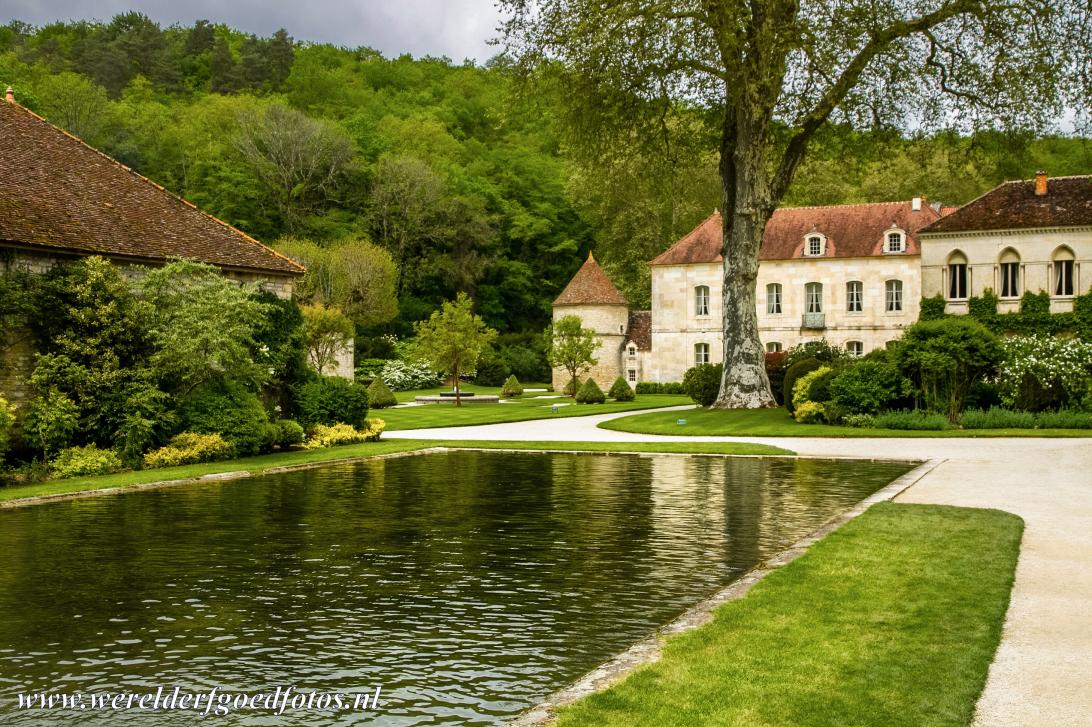
The Cistercian Abbey of Fontenay was founded by Bernard of Clairvaux in 1118. The abbey was built in the Romanesque style. The abbey is situated in the Valley of Fontenay, near Montbard, a small town in the northeast of France. The Abbey of Fontenay is magnificent in its simplicity. The Cistercian Abbey of Fontenay was inscribed on the UNESCO World Heritage List in 1981.

The Cistercian Abbey of Fontenay was founded by Bernard of Clairvaux in 1118. The abbey was built in the Romanesque style. The abbey is situated in the Valley of Fontenay, near Montbard, a small town in the northeast of France. The Abbey of Fontenay is magnificent in its simplicity. The Cistercian Abbey of Fontenay was inscribed on the UNESCO World Heritage List in 1981.
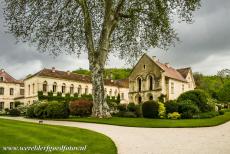
Cistercian Abbey of Fontenay: Except for the demolished refectory, the abbey retains almost all of its original buildings. Amid the buildings stands an imposing and historic plane tree, planted in 1780. The almost 250 year old plane tree is approximately 40 metres high. Once, the monks cultivated vegetables and medicinal plants in the abbey gardens. The gardens were redesigned after World War II.
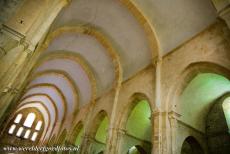
Cistercian Abbey of Fontenay: The 12th century Romanesque church of the abbey. The sunlight creates beautiful colour contrasts between the lightly tinted yellowish stones, the green shades of the surrounding woods and gardens and the blue sky. The founder of the abbey, Bernard of Clairvaux, did not reject art or beauty, but he believed that only light should enter a church. The Cistercian Abbey of Fontenay was declared a UNESCO World Heritage in 1981.
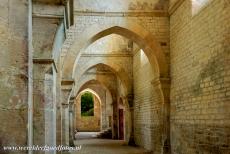
Cistercian Abbey of Fontenay: A passageway to the Abbey Church. The buildings of the abbey are almost wholly unadorned. The abbey church was built in the Burgundian Romanesque style between 1139 and 1147. The church has no bell tower. The former Abbey of Fontenay is one of the oldest preserved cistercian abbeys in the world.
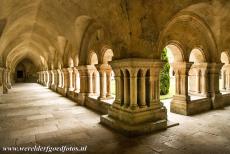
Cistercian Abbey of Fontenay: Each day of the year, the cloisters are bathed in daylight. The 12th century Romanesque cloisters of the abbey have remained completely intact. The columns have capitals, some of them are adorned with botanical motifs. The abbey was very wealthy from the 12th century through the 15th century.
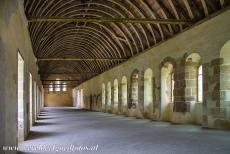
Cistercian Abbey of Fontenay: Daylight is shining through the windows of the dormitory of the monks, creating a pattern of light and shadow on the floor, the spacious room has a magnificent oak framework which dates back to the 15th century. All the monks slept in the dormitory, fully clothed on simple cots. The dormitory looks like the upside-down hull of a ship.
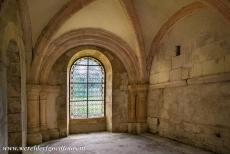
Cistercian Abbey of Fontenay: The Chapter Room was used for meetings. A gentle glow of light shines through the stained glass windows of the room, the Chapter Room and Common Room are connected by a doorway. The Common Room was used for several tasks such as textile and leather works. The Common Room was often the only room in a monastery where a fire was lit.
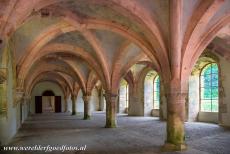
Cistercian Abbey of Fontenay: The daylight shining through the stained glass windows gives the Commom Room a gentle pink glow. The first part of the room was exclusively reserved for the monks, who copied and illuminated manuscripts by hand. Nowadays, the Medieval manuscripts created in the Abbey of Fontenay are preserved in several public libraries in France.
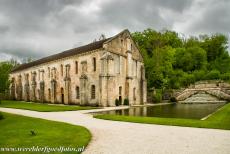
Cistercian Abbey of Fontenay: The abbey forge was built by the monks towards the end of the 12th century. The monks extracted iron ore from a hill nearby the abbey. The forge of the abbey is probably one of the oldest metallurgical plants in Europe. The monks produced iron tools and sold them in the neighbouring areas.
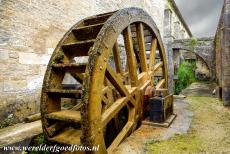
Cistercian Abbey of Fontenay: The huge water wheel next to the forge, a diversion of the river of Fontenay runs along the forge and turned the water wheel which powered the tilt hammers of the forge. When the monks left the abbey, it was converted into a paper mill. In 1906, the paper mill was demolished and the Abbey of Fontenay was restored to its former glory.
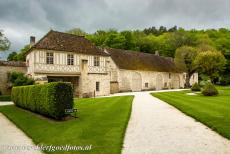
Cistercian Abbey of Fontenay: The Porter's Lodge and Hostelry. The second floor of the Porter's Lodge was added in the 15th century. The second floor contained a tiny room for a monk who served as porter. The Abbey of Fontenay is one of the rare UNESCO World Heritage Sites that is privately owned.
